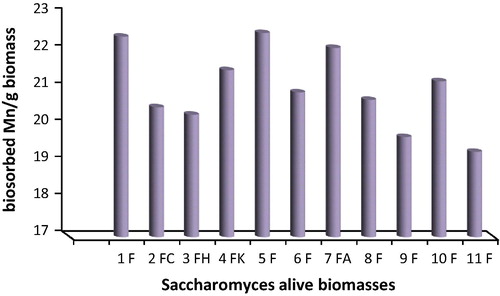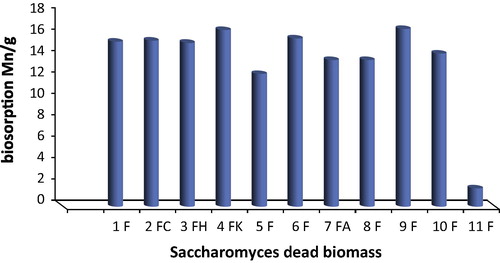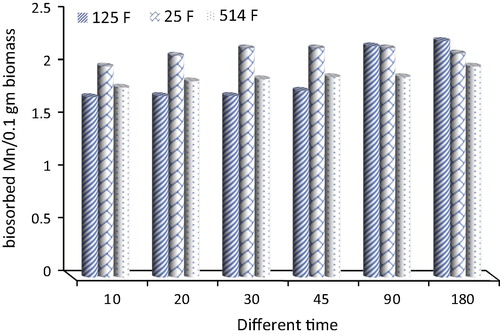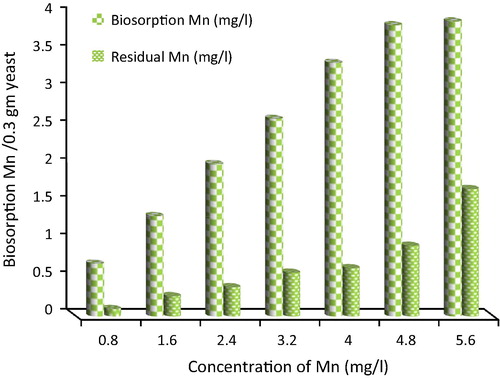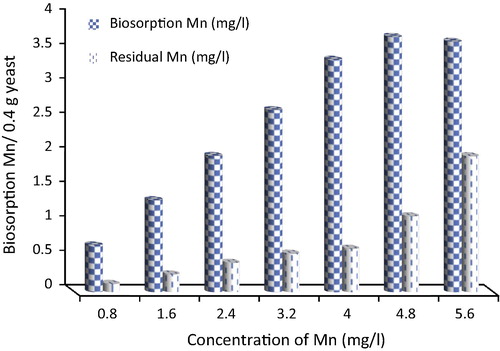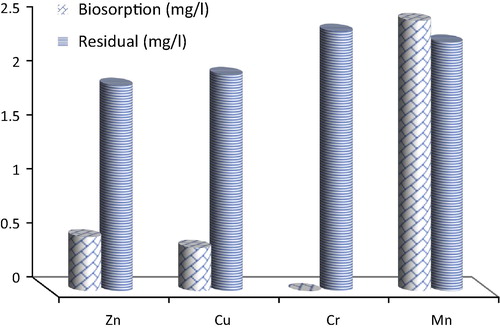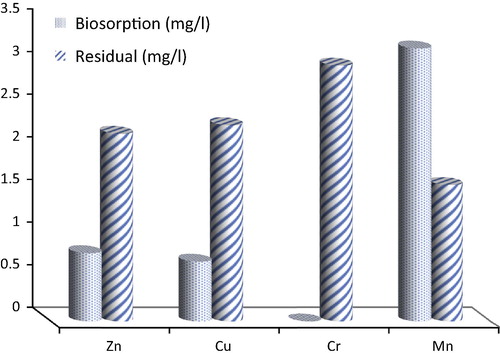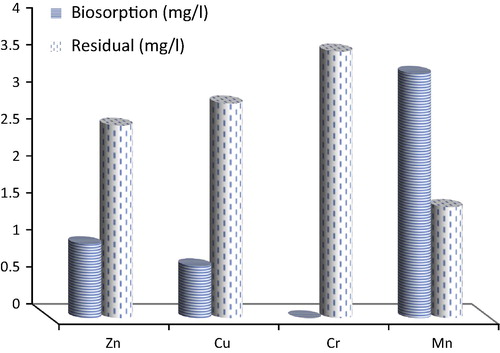Abstract
Heavy metal pollution has become one of the most serious environmental problems today. Biological methods such as biosorption or bioaccumulation strategies for the removal of metals ions may provide an attractive alternative to existing technologies. Microorganisms, as heavy metal bioadsorbents, offer a new alternative for removal of toxic or valuable metals in water. Saccharomyces cerevisiae has received increasing attention due to its unique nature and capacity for metal sorption. It is one of the most promising biosorbents capable of removing metal ions from aqueous solution. Manganese occurs naturally in many surface water and groundwater sources and in soils that may erode into this water. Eleven S. cerevisiae yeast strains in alive and dead forms were screened for biosorption and bioaccumulation of manganese from artificial aqueous solution. S. cerevisiae F-25 in alive form was found to be highly biosorbent for Mn+2 and biosorbed 22.5 mg Mn+2/gm yeast biomass. Optimization of environmental conditions reveals that optimum concentrations for maximum Mn2+ biosorption by S. cerevisiae F-25 in alive form were 4.8 mg Mn2+/l after 30 min at pH 7, agitation 150 rpm and yeast biomass concentration 0.1 gm/l at 30 °C. Competition of Mn+2 with other heavy metals shows that Mn+2 in control sample without, any other heavy metals added in solution at 4.8 mg/l of the biosorbed Mn+2 was 41.3 mg/g biomass. Addition of other heavy metals affects the percent of biosorbed Mn+2.
Introduction
Heavy metal pollution has become one of the most serious environmental problems today. Manganese is released into the environment by industries such as fertilizers, petrochemicals, electro-plating, tanneries metal processing, and mining. Exposure to manganese causes neurotoxicity [Citation1], low hemoglobin levels [Citation2] and gastrointestinal accumulation [Citation3]. However, human activities are also responsible for much of the manganese contamination in water in some areas. Water to be used in the textile, dyeing, beverages and white paper industries should contain less than 0.05 mg/L of manganese. To remove the stress of heavy and toxic metals, environment friendly approach must be applied and use of naturally occurring microbe must be emphasized [Citation4]. Biological methods such as biosorption or bioaccumulation strategies for the removal of metals ions may provide an attractive alternative to existing technologies. Microorganisms, as heavy metal bioadsorbents, offer a new alternative for removal of toxic or valuable metals in water. Bacteria, yeast, fungi, algae all of them can be used for remediation processes and it is always recommended that microbe used for bioremediation must have natural decontamination process and the method should be cost-effective [Citation5]. Moreover, microorganism can detect very less concentration of toxic metals in water which serve as an added return to the remediation process [Citation6]. Saccharomyces cerevisiae has received increasing attention due to its unique nature and capacity for metal sorption. It is one of the most promising biosorbents capable of removing metal ions from aqueous solutions. Heavy metals can be competently removed from water and other aqueous environments by S. cerevisiae [Citation7,Citation8].
Yeast cells bind double valence metals on their outer surface owing to phosphomannan content in their cell walls and the presence of free carboxyl, hydroxyl, amine, phosphate and hydrosulphide groups in surface proteins [Citation26,Citation3,Citation10]. S. cerevisiae in different forms has been studied for different purposes of research, for example, living cell/dead cell [Citation9], intact cell/deactivated cell, immobilized cell/free cell [Citation10], raw material/pretreated cell by Physicochemical process, wild type/mutant cell, flocculent/non-flocculent cell, [Citation11] engineered/non-engineered cell, lab culture/waste industrial cell and cells from different industries [Citation12]. A number of references have proved that S. cerevisiae can remove toxic metals, recover precious metals and clean radionuclides from aqueous solutions to various extents. [Citation13] reported the recovery of light metals, such as aluminum by S. cerevisiae. [Citation13,Citation14] proved that the yeast cells of S. cerevisiae treated with hot alkali were capable of accumulating a wide range of heavy metal cations, S. cerevisiae as biosorbents in metal biosorption have many advantages: Firstly, S. cerevisiae is easy to cultivate at large scale. The yeast can be easily grown using unsophisticated fermentation technique sand inexpensive growth media as well as the yield of the biomass is high [Citation9]. Secondly, the biomass of S. cerevisiae can be obtained from various food and beverage industries as a by-product and easier to get from fermentation industry in comparison with other types of waste microbial biomass. Microorganisms used in enzymatic industry and pharmaceutical industry are usually involved in the secret of their products, which makes industries reluctant to supply the waste biomass. The supply of S. cerevisiae as waste residuals is basically stable. Thirdly, S. cerevisiae is generally regarded as safe; therefore, biosorbents made from S. cerevisiae can be easily accepted by the public when applied practically. Fourthly S. cerevisiae, is an ideal model organism to identify the mechanism of biosorption in metal ion removal, especially to investigate the interactions of metal–microbe at molecular level. In fact, S. cerevisiae, as a model system in biology, has been explored fully in molecular biology [Citation15]. S. cerevisiae can be easily manipulated genetically and morphologically, which is helpful to genetically modify the yeast as appropriate for various purposes of metal removal.
Materials and methods
Yeast strains
Eleven yeast S. cerevisiae strains ( and ) were obtained from Culture Collection of Microbial Chemistry Dep. National Research Center, Giza, Egypt. The yeast strains were then routinely maintained on PDA at 4 °C.
Preparation of metal ions
The stock metal ion solution was prepared by dissolving manganese chloride of analytical grade in deionized water to obtain a concentration of 1000 mg/l further dilutions. Different concentrations were made during the course of the experiments.
Screening yeasts biomass for the biosorption of Mn2+
Fifty ml double distilled water (ddH2O) was amended with MnCl2⋅4H2O to attain concentrations 2.6 mg Mn2+/l, then introduced in 250-ml Erlenmeyer flasks inoculated with 0.1 g from different yeast strains biomass in alive and dead forms and then incubated for 180 min at 28 °C in a rotary shaking incubator (200 rpm). Samples were filtered using Whatman No. 1 filter paper. The concentration of manganese remaining in the filtrate was determined using Atomic adsorption (thermo scientific ice 3000 series), the absorbed Mn+2 was calculated by Atomic adsorption, and this method repeated with strains of biosorbents with decreasing time to 90 min.
Effect of contact time on biosorption
Under the above conditions samples were withdrawn at 10, 20, 30, 45, 90 and 180 min. intervals and analyzed for Mn+2 for the aqueous solution contained S. cerevisiae F-125, S. cerevisiae F-25, S. cerevisiae F-514.
Effect of initial Mn2+ ions concentrations
Different concentrations of Mn2+ such as 0.8, 1.6, 2.4, 3.2, 4.0, 4.8 and 5.6 mg Mn/l aqueous solution contained 0.1 g/l S. cerevisiae 25 F biomass in alive form for 30 min at 28 °C in a rotary shaking incubator (200 rpm).
Effect of yeast biomass dose on biosorption
Different concentrations of S. cerevisiae F-25 biomass in alive form such as 0.1, 0.2, 0.3, and 0.4 gm/l aqueous solution contained 4.8 mg Mn2+/l were incubated for 30 min. at 28 °C in a rotary shaking incubator (200 rpm).
Effect of pH
The aqueous solution contained 0.1 g/l S. cerevisiae F-25 biomass in alive form and 4.8 mg Mn2+/l, was adjusted to pH 4.5, 5, 5.5, 6, 6.5, 7, 7.5, 8, 8.5, and 9 using 0.1 M HCl or 0.1 M NaOH, left for 30 min. at 28 °C in a rotary shaking incubator (200 rpm).
Effect of different agitation speeds
Different agitation speeds such as 100, 150, 200 and 250 rpm for 30 min were used to study their effect on the Mn+2 biosorption in solution containing 4.8 mg Mn2+/l and 0.1 g alive biomass S. cerevisiae F-25.
Effect of temperature
The temperature was maintained at 20 °C, 25 °C, 30 °C, 35 °C and at 40 °C and agitation speeds 150 rpm were applied to study their effect on the Manganese biosorption in solution containing 4.8 mg Mn2+/l and 0.1 g alive biomass of S. cerevisiae F-25.
Competitive adsorption between manganese and other heavy metals
Different concentrations of Cu+2 in the form CuSO4⋅5H2O ions, Cr+6 in the form K2Cr2O7 and Zn+2 as ZnSO4 such as (2.4, 3, 3.6 mg/l) were introduced with aqueous solution contained Mn+2 at concentration 4.8 mg/l and 0.1 g/l S. cerevisiae F-25 biomass in alive form for 30 min at 30 °C in a rotary shaking incubator (150 rpm).
Results and discussion
Effect of S. cerevisiae strains of Mn+2 biosorption
The data in and illustrated that all tested S. cerevisiae strains in the alive form were more efficient in Mn2+ biosorption than the dead form. The maximum biosorption efficiency 22.5 mg Mn2+/g yeast biomass represents 86.53% was blinded by alive cells of S. cerevisiae F-25 followed by strains of S. cerevisiae F-125, S. cerevisiae FA-426, which recorded 22.4, 22.1, mg Mn2+/g biomass, respectively. They followed by S. cerevisiae strains coded FK-907, F-514 and F-524, which blinded 21.5, 21.2, 20.9 mg Mn2/g biomass. So, the above six yeast strains in alive form were subjected to further study. The data in showed that S. cerevisiae F-125 alive, S. cerevisiae F-25F, S. cerevisiae F-514 in the alive form proved to be the most biosorbents to Mn2+, as they could absorb 21.9, 21.9, 21.7 mg Mn2+/g biomass, respectively. A number of references have proved that S. cerevisiae can remove toxic metals, recover precious metals and clean radionuclides from aqueous solutions to various extents [Citation13,Citation12]. Comparing two strains of S. cerevisiae for the biosorption of cadmium one strain is ATCC 834 and another strain, ATCC 24858. They found that the thicker mannan layer and the larger specific surface layer seemed to benefit a larger cadmium uptake capacity for the strain S. cerevisiae ATCC 834. [Citation16] also confirmed that Sr+2 accumulations occur mainly in the vacuole of the living yeast cell of S. cerevisiae. Tripeptide glutathione (GTH) is a typical low molecular weight cellular thiol and functions as a storage form of endogenous sulfur and nitrogen as well as detoxification of metal ions.
Table 1 Screening of some alive yeast Saccharomyces cerevisiae strain for Mn+2 biosorption after 90 min at 28 °C, 200 rpm, at 2.6 ppm.
Effect of contact time
The uptake of metal ions by microorganisms in batch systems has been shown to occur in two stages: an initial rapid stage (passive uptake), followed by much slower process (active uptake). The first stage is physical adsorption or ion exchange at the surface of the biomass, which is biosorption. The biosorption equilibrium occurs at the end of rapid physical adsorption stage (first-stage). As shown in the biosorption capacity increased as the contact time increased. The biosorption of Mn2+ by S. cerevisiae F-25 yeast biomass was rapid for first 30 min. and equilibrium was nearly reached after 45 min. Results revealed that the highest removal efficiency for Mn2+ by yeast biomass was occurred after 30 min until 45 min. Biosorption kinetics with an initial rapid metal uptake followed by slow uptake was observed, and this kinetic model has been accepted for various biosorbents such as bacteria and fungi (yeast) under similar operation conditions [Citation17]. The obtained results are in agreement with [Citation18] as they proved that biosorption of manganese increased with time and maximum manganese biosorption was 18.95 mg Mn2+/g S. cerevisiae after 20 min. [Citation19] have reported an equilibration time of 60 min for copper biosorption by Saccharomyces carlsbergensis, Penicillium chrysogenum, and Streptomyces rimosus. The short equilibrium time for S. cerevisiae may be attributed to the high affinity of the cell surface for manganese transport. [Citation20,Citation21] optimized the sorption time for chromium(III) by S. cerevisiae, and showed that a 30 min sorption period is the best option to ensure the metal removal from solution and good recovery from biosorbent.
Effect of initial Mn2+ ions concentration and dose of yeast
Figs. – show that removal efficiency increased with increasing the metal ions concentration. On the contrary biosorption decreases with increasing dose of biomass. The best removal occured at 0.1 g yeast. This agrees with [Citation18] who proved that biosorption increased with rise in manganese concentration in the test solution. Rise in manganese concentration from 25 to 200 mg Mn2+/l resulted in an increase in its uptake by S. cerevisiae from 1.54 to 18.95 mg/g 18-fold. Similar performance has been reported by [Citation17,Citation22] suggested that all kinds of yeast biomass (Fodder yeast, waste brewers yeast and bakers yeast) used in the study were able to remove more than 90% of lead present in the solution within 20 min. The present results are supported by literature references, suggesting that decreasing the biomass resulted in the increase of the metal removal due to exhaustion of metal ion in the biosorption medium or the interaction between the metal ion binding sites [Citation23]. An increase of electrostatic interaction at high biomass concentration inhibited metal biosorption. When the biomass concentration is low, metal ions in the solution would not only be adsorbed to the surface of the biomass, but also enter into intracellular part through facilitating the concentration gradient of metal ion [Citation24]. It should be mentioned that the cadmium ion adsorption capacity decreased with increase of biosorbent dosage [Citation25]. Their theory is similar to that advanced by [Citation26] to account for the cell surface remaining unsaturated at higher biosorbent dosage. High biosorbent concentrations at (4%, v/v) are known to cause cell agglomeration and consequent reduction in inter-cellular distance resulted in decrease in metal removal (%). Also, it is clear that carboxyl group, phosphoric and amino groups in the cell wall reported to be involved on metal ion adsorption group [Citation27,Citation28]. In other words, metal removal is higher when the inter-cellular distance is more (at low biosorbent concentration), as this condition ensures optimal electrostatic interaction between cells, a significant factor for biosorption [Citation23].
Fig. 4a Estimation of the biosorbed and residual Mn+2 different concentrations in the culture filtrates of 25F by 0.1 gm dose of yeast.
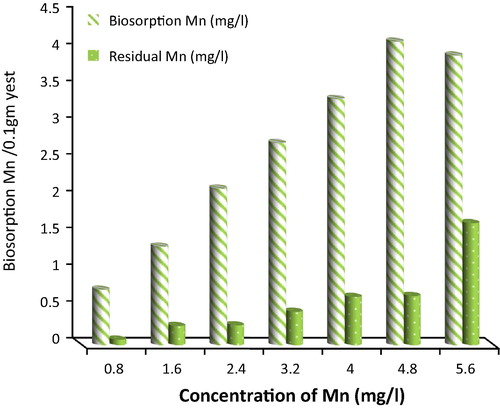
Fig. 4b Estimation of the biosorbed and residual Mn+2 different concentrations in the culture filtrates of 25F by 0.2 gm dose of yeast.

Effect of pH
The charge of the adsorbate and adsorbent depends on the pH. The adsorption of Mn+2 as a function of pH was measured as shown in . There was an increase in biosorption uptake equilibrium in Mn2+ with increasing pH from 4.5 to 9. pH is a significant factor for maintaining the surface characteristics of the biosorbent, sustaining the chemical properties of biosorbate and a vital controlling aspect in the biosorption process [Citation29]. The charge of the adsorbate and adsorbent often depends on the pH [Citation30]. S. cerevisiae contains chitin–chitosan units and amino acids such as histidine, which serve as a matrix of –COOH and –NH2 groups. This matrix interacts with ions and this interaction depends on the pH of the solution which finally leads to removal of ions [Citation7]. So pH of the solution must be appropriate for interaction. It was studied that biosorption by S. cerevisiae is optimum above pH 5 [Citation31]. Generally, an increase of pH caused protonation of metal ions binding sites exposed by cellular surface. However, a decrease of pH causes competition between protons and positively charged metal ions [Citation32]. The pH above 5.0 was reported for absorption of Cu+2, Zn+2 and Fe+2 by S. cerevisiae [Citation7,Citation29].
Table 2 Effect of different pH on Mn+2 uptake after 30 min at 28 °C, 200 r rpm at 4.8 ppm.
Effect of agitation speed
Removal of Mn+2 increases with the agitation speed as shown in ; until 150 rpm the removal increases slightly but it decreased when the agitation speed increases to 200 or 250 rpm. Accumulation starts to predominate after some time of the S. cerevisiae around 150 rpm of agitation. This results in agreement with [Citation33] where maximum chromium biosorption occurred at 150 rpm agitation. [Citation28] indicated that, 150 rpm is the optimum agitation for settlement of heavy metals in biosorption media. This is may be due to mucilage hydrophilic character, and several hydrogen bonds are formed between polyelectrolyte and water molecules. This association tends to occupy larger surface area causing its very high viscosity. [Citation34,Citation35] stated that natural polyelectrolyte has been used as auxiliary of flocculation and coagulation in wastewater treatment and water cleaning process. Iron and copper settlement increased more than 2-fold with rise in agitation speed from 50 to 150 rpm, beyond which there was no further increase [Citation34].
Table 3 Effect of agitation speed on Mn+2 uptake after 30 min at 28 °C, at 4.8 ppm.
Effect of temperature
Temperature has an influence on the biosorption of metal ions, but to a limited extent under a certain range of temperature, which indicates that ion exchange mechanism exists in biosorption to some extent. Biosorption process is usually not operated at high temperatures because it will increase the operational cost [Citation24]. In our results the different temperatures from 20 °C to 40 °C proved that the optimal temperature value is greater and does not have more effect on biosorption of Manganese. [Citation36] found that temperature (5–40 °C) had minor effect on the accumulation level of Cu+2, Co+2 or Cd+2 by free cells of S. cerevisiae in suspension. Adsorption reactions are normally exothermic, so biosorption capacity increases with decrease of temperature [Citation37]. In the range of 15–40 °C, the maximum equilibrium biosorption capacity for Pb(II), Ni(II) and Cr(VI) ions by the inactive S. cerevisiae was reached at temperature of 25 °C. The decrease in capacity at higher temperature between 25 and 40 °C revealed that the processes of biosorption for these metal ions by S. cerevisiae are exothermic. The decrease of biosorption capacity at higher temperature may be due to the damage of active binding sites in the biomass [Citation38]. However, [Citation17] found that the metal biosorption of Cr(VI) by S. cerevisiae increases with increasing temperature in the range of 25–45 °C. They explained that higher temperature would lead to higher affinity of sites for metal or binding sites on the yeast. The energy of the system facilitates Cr(VI) attachment on the cell surface to some extent. When the temperature is too high, there is a decrease in metal sorption due to distortion of some sites of the cell surface available for metal biosorption ().
Table 4 Effect of different temperatures on Mn+2 uptake after 30 min, 150 rpm at 4.8 ppm.
Competing Mn2+ ions/co-ions
Real industrial effluent usually contains various ionic components, including metal cations and anions. Some studies indicated that cations and anions additional to the ions of interest have a generally detrimental impact on metal accumulation [Citation39]. Usually, the biosorption capacity of one metal ion is interfered and reduced by co-ions, including other metal ions and anions presenting in solution; however, the gross uptake capacity of all metals in solutions remains almost unchangeable. The results show that Mn+2 in control sample without any other heavy metal added in solution at 4.8 mg/l of the biosorbed Mn+2 was 41.3 mg/g biomass. Additions of other heavy metals affect the percent of biosorption which decreased to 33 mg/g yeast biomass, Figs. –. [Citation40] studied the competitive effect occurred in a mixed solution containing different metal ions during the biosorption process by flocculating brewer’s yeast. The yeast of S. cerevisiae seems to have more affinity, higher selectivity and biosorption capacity in aqueous solutions. [Citation41] observed that the competitive biosorption capacities of S. cerevisiae yeast for all metal ions were lower than that under no competitive conditions. The decrease of metal uptake in competitive conditions was thought to be a response to increased competition between same charged species for binding’s sites of yeast cells. [Citation42] investigated the presence of the cationic impurities such as Al, Be, Cd, Cr, Fe, Mn, Pb, Ce, and Sm. The results showed that there were no significant differences. Light metal ions, such as Ca+2, Na+, K+, are present in industrial wastewater. The experimental data have shown that those light metal ions have little effect on heavy metal biosorption, which indicates that the affinity of the yeast for light metal ions is far less than for heavy metal ions. Alkali metal ions and alkaline earth metals were not absorbed by yeast, possibly because they lack the ability to form complexes with the various ligand groups present on the biomass surface [Citation24,Citation37,Citation43].
Notes
Peer review under responsibility of Housing and Building National Research Center.
References
- G.D.VêlizS.MoraP.GómezM.T.DossilJMontieC.ArriagadaF.AboitizS.AguilarBehavioral effects of manganese injected in the rat sub stantianigra are potentiated by dicumarol, DT-diaphoras inhibitorPharmacol. Biochem.72004245251
- C.S.BurgoaC.RiosL.A.MercadoS.A.SerranoF.C.ValleR.A.E.WynterJ.L.T.SangradorJ.P.V.BarraganY.R.AgudeloS.MontesExposure to manganese health effects on the general population, a pilot study in central MexicoEnviron. Res.85200190104
- S.HenrikM.D.ThomsenO.D.V.M.SvendsenS.KlastrupIncreased concentration in the liver after oral intakeAcad. Radiol.1120043844
- N.DasR.VimalaP.karthikaBiosorption of heavy metals an overviewInd. J. Biotech.722008159169
- M.AhemadM.KibretRecent trends in microbial biosorption of heavy metals: a reviewBiochem. Molecul. Biol.1120131926
- M.GavrilescuRemoval of heavy metals from the environment by biosorptionEng. Life Sci.432004; 219232
- R.DhankharA.HoodaR.SolankiP.A.SaingerSaccharomyces cerevisiae a potential biosorbent for biosorptionof uraniumInt. J. Eng. Sci. Technol.36201153975407
- J.WangC.ChenBiosorption of heavy metals by Saccharomy cescerevisiae, a reviewBiotechnol. Adv.5242006427445
- A.KapoorT.ViraraghavanFungal biosorption. An alternative treatment option for heavy metal bearing wastewatersBioresour. Technol.531995195206
- F.VeglioF.BeolchiniRemoval of metals by biosorption, a reviewHydrometallurgy441997301316
- P.A.MarquesH.M.PinheiroJ.A.TeixeiraM.F.RosaRemoval efficiency of Cu+2, Cd+2 and Pb+2 by waste brewery biomass, pH and cation association effectsDesalination1241999137144
- J.K.ParkJ.W.LeeJ.Y.JungCadmium uptake capacity of two strains of Saccharomyces cerevisiae cellsEnzyme Microb. Technol.332003371378
- E.J.SchottR.C.GardnerAluminum – sensitive mutants of saccharomycesMol. GenGenet.25419976372
- D.BradyA.StollJ.R.DuncanBiosorption of heavy metal cations by non-viable yeast biomassEnviron. Technol.151994429438 1994F
- D.Q.ZhouMicrobiologysecond ed.2002Higher Education PressBeijing [in Chinese]
- S.V.AveryJ.M.TobinMechanisms of strontium uptake by laboratory and brewing strains of Saccharomyces cerevisiaeAppl. Environ. Microbiol.58199238833889
- N.GoyalS.C.JainU.C.BanerjeeComparative studies on the microbial adsorption of heavy metalsAdv. Environ. Res.72003311319
- K.ParavathiR.NareshkumarR.NagendranBiosorption of manganese by Aspergillus niger and Saccharomyces cerevisiaeWorld J. Microbial. Biotechnol.232006671676
- K.ChandrasekharS.SubramanianJ.M.ModakK.A.NatarajanRemoval of metals using an industrial biomass with reference to environmental controlInt. J. Mine Process531998107120
- E.LukL.T.JensenV.C.CulottaThe many high ways for intracellular traffic king of metalsJ. Biol. Inorg. Chem.82003803809
- A.I.FerrazT.TavaresJ.A.TeixeraCr (III) removal and recovery Saccharomyces cerevisiaeChem. Eng. J.10520041120
- D.C. Aleksandra, T. Tomasz, M. Kamil, Applicability of different kinds of yeast biomass to lead removal from water. Chair of Fermentation Technology and Technical Microbiology University of Agriculture in Krakow, vol. 17 (1), doi: http://doi:10.5601/jelem, 2012.
- J.K.ParkS.B.ChoiMetal recovery using immobilized cell suspension from breweryKorean J. Chem. Eng.1920026874
- J.L.WangImmobilization Techniques for Biocatalysts and Water Pollution Control2002Science PressBeijing [in Chinese]
- P.VasudevanV.PadmavathyS.C.DhingraBiosorption of monovalent and divalentions on baker’s yeastBioresour. Technol.822002285289
- W.H.ZouR.P.HanZ.Z.ChenJ.ShiH.M.LiuCharacterization and properties of manganese oxide coated zeolite (MOCZ) as adsorbent for removal of copper(II) and lead (II) ions from solutionJ. Chem. Eng. Data512006534541
- S.A.El AasarAdaptive tolerance of Trichoderma hamatum in cadmium, copper and lead heavy metalsEgy. J. Biotech.212005278294
- S.G.AmberM.AttiaH.A.AhmedHeavy metals bio-remediation by immobilized Saccharomyces cervisiae and Opuntia ficusindica wasteJ. Am. Sci.682010
- R.DebarshiG.PriyaV.NeerajP.MonikaP.KrishnaSinghBioremediation of arsenic (III) from water using baker yeast sacchromy ces cerevisiaeInt. Environ. Biorem. Biodegrad.120131419
- Z.AksuF.GonenBiosorption of phenol by immobilized activated sludge in a continuous packed bed, prediction of breakthrough curvesProcess Biochem.3952004599613
- M.MapoleloN.TortoTrace enrichment of metal ions in aquatic environments by Saccharomyces cerevisiaeTalanta64120043947
- G.M.NajaB.VoleskyTreatment of metal-bearing effluents, removal and recoveryL.K.WangJ.P.ChenY.T.HungN.K.ShammasHandbook on Heavy Metals in the Environment2010Taylor & FrancisBoca Raton, F.L.
- u.Handanb.y.Kemalk.yusufc.AvniBiosorption of chromium(VI) and Cr(VI) ions on to S. cerevisiae, determination of biosorption from aqueous solution by cone biomass of Pinus sylvestrisHeat J. Hazard Mater. B1002002219229
- M.A.OliveiraC.RodriguesE.M.dos ReisJ.NozakiProduction of fungal protein by solid substrate fermentation of cactus Cereus peruvianus and Opuntia ficus indicaQuím. Nova2432001
- J.NozakiI.MesserschimidtD.G.RodriguesArq. Biol. Technol.361993761
- D.BradyJ.R.DuncanBioaccumulation of metal-cations by Saccharomy cescerevisiaeAppl. Microbiol. Biotechnol.411994149154
- A.KapoorT.ViraraghavanFungi as biosorptionD.A.J.WaseC.F.ForsterBiosorbents for Metal Ions1997Taylor & FrancisLondon, UK6785
- A.ÖzerD.ÖzerComparative study of the biosorption of Pb(II), Ni(II) and Cr (VI) ions on to S. cerevisiae determination of biosorption heatsJ. Hazard. Mater. B1002003219229
- J.H.SuhD.S.KimEffects of Hg+2 and cell conditions on Pb+2 accumulation by Saccharomyces cerevisaeBioprocess232000327329
- A.I.FerrazJ.A.TeixeiraThe use of flocculating brewer’syeast for Cr(III) and Pb (III) removal from residual wastewatersBioprocess211999431437
- Y.GoksungurS.UrenU.GuvencBiosorption of cadmium and lead ions by ethanol treated waste baker’syeast biomassBioresour. Technol.962005103109
- S.K.DasC.S.KedariS.S.ShindeS.GhoshS.JambunathanPerformance of immobilized Saccharomyces cerevisiae in the removal of long lived radionuclides from aqueous nitrate solutionsJ. Radioanal. Nucl. Chem.2532002235240
- D.BradyJ.R.DuncanCation loss during accumulation of heavy-metal cations by Saccharomyces cerevisiaeBiotechnol. Lett.161994543548

